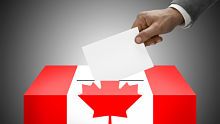
The three major national political parties have staked out differing positions during the 2015 federal election campaign concerning personal, small business and corporate taxes, presenting voters with competing visions of how tax policy could generate economic growth while providing tax relief for families, seniors and middle- and low-income individuals.
The governing Conservative Party of Canada has taken a steady-as-it-goes approach, announcing no new bold initiatives. Instead, the party is standing on its tax-cutting record of the past nine years, which includes lower tax rates for small businesses and corporations, a lower GST rate, income-splitting for families and seniors as well as a raft of tax credits.
In fact, the Tories have gone so far as to say they would pass a “tax lock” law prohibiting the federal government from raising personal income taxes, sales taxes, or discretionary payroll taxes over the next four years.
“Tax money belongs to Canadians, not the government,” said Prime Minister Stephen Harper in a statement announcing the promise.
Meanwhile, the New Democratic Party of Canada (NDP) has said it would raise corporate tax rates to 17% from 15% as part of its election platform, putting Canada more in line with the corporate tax rates in other G7 countries, the NDP argues. Personal income tax rates would stay where they are under an NDP government, and the budget would be balanced.
In contrast to the NDP, the Liberal Party of Canada says it intends to leave corporate tax rates where they are; however, the Liberals would lower personal income tax rates in the middle-income tax bracket (those earning between $44,702 to $89,401) to 20.5% from 22%, paying for it by introducing a new tax bracket, at a 33% tax rate, for Canadians earning more than $200,000 a year. The Liberals say they intend to run modest, short-term budget deficits.
“Given that the highest-income Canadians have, in general, done very well over the years, and the middle-income earners less so,” says John McCallum, Liberal finance critic and candidate for the new riding of Markham — Thornhill, “there’s a case to be made for asking those at the top to pay a little bit more and using the money to give a break to those in the middle.”
A decrease in the middle tax rate would be a “long overdue” positive change, says Rick Robertson, associate professor with the Richard Ivey School of Business at Western University in London, Ont., considering that the low tax bracket was dropped to 15% from 16% in 2005, and lowered from 17% before then. Middle-income earners are in line for a break, he argues.
“There’s quite a jump from the low to the middle tax rate — seven percentage points — on what I wouldn’t call massive incomes,” he says.
However, Robertson believes that any cut to the middle tax rate would be better paid for with an increase in the GST/HST rather than an increase in the top tax rate, which introduces a disincentive for people to earn more, he argues.
One noted economist disagrees with McCallum’s assessment that Canada is struggling with troubling income inequality, suggesting that the Canadian tax system is sufficiently progressive and that creating a new top tax rate is unnecessary.
“The case is not very strong for this increase in the top rate,” says Jack Mintz, president’s fellow at the School of Public Policy at the Univeristy of Calgary. “Once you start hitting over 50% [combined federal-provincial] tax rate — 54% for Ontario and Quebec, which is a big part of the Canadian population — you start impacting on incentives. People will start avoiding taxes or leaving money in their Canadian-controlled private corporations (CCPCs) [small businesses].”
Both the NDP and the Liberals say they would lower the small business tax rate to 9% from 11%, consistent with the schedule of decreases the Conservatives have proposed. However, the Liberals have said that they are concerned that some wealthy individuals are using CCPCs as an income-splitting tool rather than using the tax savings to invest in their businesses.
“To the extent that we can mitigate the use of [the small business rate] for avoiding taxes, we would,” McCallum says.
The NDP, for its part, stands alone on proposing to raise corporate tax rates, arguing that the current combined federal-provincial Canadian corporate tax rates are significantly below those in the U.S. The party’s proposal to raise corporate tax rates would still leave Canada below the U.S. and the G7 average, the NDP argues.
Raising the corporate tax rate will help “restore fairness and balance to the tax revenue the Government of Canada receives year,” says the NDP’s fiscal plan document.
However, raising the corporate tax rate may change the tax equilibrium in unexpected ways, Robertson says. For example, corporations may reconsider whether to locate a head office or factory in Canada.
“Tax is not the most important factor, but it’s one of the variables,” he says.
Robertson also points out that the current debate in the U.S. is focused on lowering the corporate tax rate. Thus, plans to increase corporate tax rates here may be the wrong move at the wrong time, he suggests.